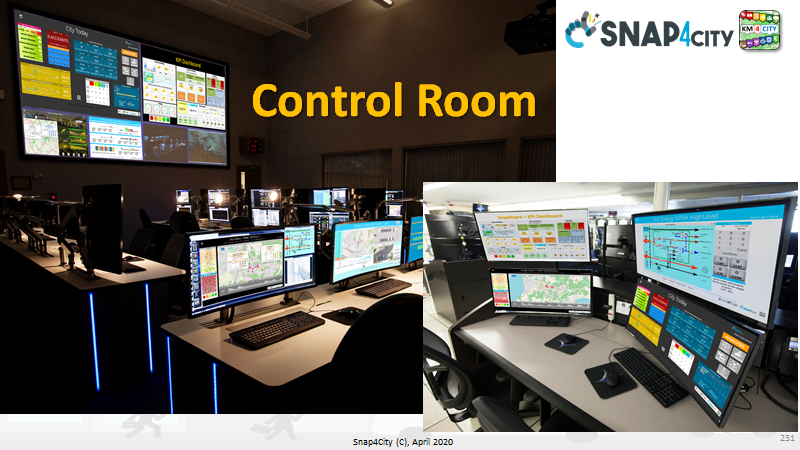
The Snap4City solution is fully integrated with the management of Video Wall of ISEMC, and similarly with other producers of video wall controllers.
A control room (for smart city or large plant or village or resort) includes a video wall and a number of consolle operators. The concept of the control room may be implemented with a physical room or set of rooms in which a number of flat panels, walls are provided to the on site operators for real time control of the operation in the city/site. As well as, the control room can be virtual in which a set of dashboards are connected each other, and are accessible to different operators and stakeholders from their offices and sharing a chat connected to each specific dashboard and domain. All these possibilities are be easily configured in Snap4City and may cohexsist in the same installation.
In the most complete situations, a large wall hosting a number of tiled monitors HD (2K) or UHD (4K) is adopted. This kind of solutions can be controlled by a single computer. And thus, a number of tiled views may be shown. The entire wall could be regarded as single web page or a number of screens can be grouped in a single one, while the remaining monitors are singularly controlled by other computers. This approach may create a more stable key of interpretation and less confusion for immediate understanding of the condition. To this end a video wall controller is needed. The Main view represented in the following figure can be central (as in the figure) or placed on a side. The size of each monitor depends on the size of the room (since the objective is to allow everybody to see the critical issue on the main without moving from its place), typically from 43” to 55” could be enough.
For example, this means that energy operator could see in case of critical condition the mobility aspects put on the main. While the decision makers, walking or sitting in front of the video wall should be capable to read details in almost all monitors.
The whole video wall as well as its views should be accessible also from remote, for example as a set of Dashboards, also replicable in the situation room and/or in conference call with other external service managers, civil protection, fire brigade, etc., if any. The main issues is to provide the access to the single dashboards that can be shown on the video wall.
Each domain/monitor(s) is(are) typically managed by a domain specialist: energy, mobility, security, environment, social, etc.; which can recall the attention on a specific fact requesting to replicate its view on the main wall. At that moment, the Main view (typically 4K, UHD) is passed to the requesting Service Monitor. This swap can be performed by using a HDMI Matrix/switch device, for example the Video Wall controller of ISEMC. Thanks to Snap4City, the swap should be controllable by sending a command from the Dashboard to the HDMI Matrix controller, frmo IOT Applications, from IOT brokers, from maintenance operators, and from any kind of event on the back office or manually requested according to a number of scenarious. The video wall controlles are of two three: matrices, HDMI TX/RX, over IP. The first are almost obsolete and limited in performance and feaures. The secoond are very powerful. The latter are more expensive and flexible than the others.
A less expensive solution may consist in automatically passing a reference to the Browser hosting the Mainor setting up some service for dynamic relocation of the web pages. These last cases may not migrate the precise view of the operator in the MAIN, so that the specific context of the view to be replicated is lost, and the user getting the link restart from scratch. So that both solutions should be put in place at the same time and use for different purposes.
At the same time, each domain operator should have the possibility to have 2-4 different monitors on which operate. For each of them, two monitors are the replicas of the Mobility and Service Mobility of the main wall (that can be swapped on demand each other and with the Main if requested). The other two are devoted to the work of the operator, for example for detailed operation monitoring before requesting the attention. For example:
In some cases, for large city and/or operation, multiple operators for each domain are needed. The number of operators per domain depends of the number of verticals or areas to be controlled in real time. In some cases, the operators are offered by different stakeholders, for example, from the inhouse of the city to manage the streetlights, or for managing waste, or for managing the mobility and transport, or for controlling large events in the city. This means that the number of domains around the Main can be also changed according to the city needs.
The following figure represents an example of Video Wall for smart city control room, using Snap4City solutions and dashboards and controller for video signals of ISEMC.
Different Scenarios
Automated Control of Video Wall for control rooms